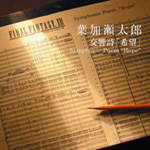Final Fantasy XII: Symphonic Poem Hope
 |
Album Title: Final Fantasy XII: Symphonic Poem Hope |
| Record Label: Hats |
|
| Catalog No.: HUCD-10015 |
|
| Release Date: March 1, 2006 |
|
| Purchase: Buy at CDJapan |
Overview
“Symphonic Poem ‘Hope'” is the main theme from Final Fantasy XII and was composed by Taro Hakase and Yuji Toriyama with the help of Robin Smith for the orchestration. This is a different move to the typical main theme that we have seen in recent Final Fantasy games, as it is completely instrumental. The actual piece is split into five different movements of very contrasting styles, and I will use this review to discuss how each movement performs on its own merits and in conjunction with the piece on the whole.
Body
The purpose of the first movement, “Overture”, is really to set the scene. It starts off with a subtle ambient synth, which is followed by a very powerful strings section. The mood of the piece is very ominous throughout the first half, and the addition of the violins is a nice touch, as it adds another dimension to the piece. All the time, the ambient synth is in the background to give the piece some more depth, as well as the occasional usage of percussion. It certainly does a good job of setting the scene, with the violins adding to the increased feeling of insecurity.
“1st mov. Overture” fades out slightly and the second movement, “2nd mov. March of a Wise Man,” starts straight away with a very powerful and resounding militaristic feel. The harmony is very dissonant; with the staccato string section is being used as the driving force behind the piece, with the double bass also adding to the feel with long bass notes. The brass section is used to perform the main melody, which is fairly generic sounding, but the addition of the flutes gives it a nice bit of variety. This section of the piece is a very big contrast from the original movement and it’ll be interesting to see how the onscreen action relates to the integration between the two sections. The end of this movement strangely sounds more like the end of the piece whole, with it having a nice cadence followed by a long build up, swell and timpani roll. Then silence…
It is fairly understandable why the last movement pretty much stops dead, because the contrast between third and second movements is even greater than that between the first and second movements. “3rd mov. Road of Hope” is a very upbeat and joyous sounding piece of music right from the beginning, but when the main melody — played by a rather muted sounding brass section — first kicks in, it isn’t really the main focus of the piece and sounds like its there to just fill a void. It’s pretty evident why this is though, because after it stops, the strong sounding violin of Taro Hakase comes to the centre stage and lights the piece up. At this point, the brass section is then used to accompany the sumptuous sounding violin as well as Yuji Toriyama on guitar. This is the longest of the five movements, and about half way through, there is a complete attitude change in the piece. It suddenly goes back to the ominous sounding first movement and and eventually ends up with Taro Hakase again taking centre stage while he performs solo over what digresses into a single pedal note.
This single pedal note continues to play in the background of the fourth movement, “Romance”, but Yuji Toriyama’s guitar playing is now being played over the top. This soon changes with the addition of a well harminsed stringed section to match the chords of his guitar. During this section, the piece becomes more soft and mellow, but the pedal note remains. The strings really add a completely different feel to the piece though, especially in the build up to the re-entry of Taro Hakase. His performance is very moving when combined with the brilliant usage of the backing strings and celesta. Near the end of this movement though, there is a very large swell, which is the build-up to the 5th and final movement. Overall, the fourth movement is very good, and I think the integration between the third and fourth movements works very well due to the subtle build up at the beginning of the fourth movement.
As the title suggests, the final movement “Road of Hope ~ Refrain” is indeed an arranged version of “3rd mov. Road of Hope,” but in a much shorter form. There is little build up as it heads straight into the main core of what made “3rd mov. Road of Hope” so good and the only real addition is extra backing from the strings section and wind instruments. Since this is the final movement, it contains the ending of the piece which starts to build up probably two thirds of the way through. “5th mov. Road of Hope ~ Refrain” is probably the least inspiring, but only because it is just a slight variation of the third movement.
Summary
Overall, “Symphonic Poem ‘Hope'” is a very solid piece and its different movements really help to keep it new and original. It is fairly short, though (approximately nine minutes), but Final Fantasy XII: Symphonic Poem Hope is only a single release, so it’s to be expected. It is definitely worth a listen if you get the chance, if only so you can hear the excellent performance by Taro Hakase.
Do you agree with the review and score? Let us know in the comments below!
4
Posted on August 1, 2012 by Jared Smith. Last modified on August 1, 2012.














